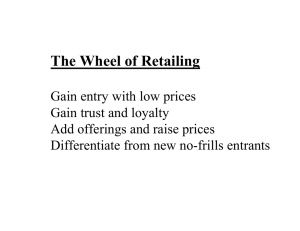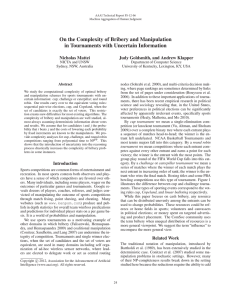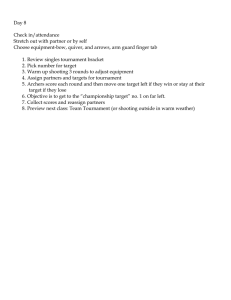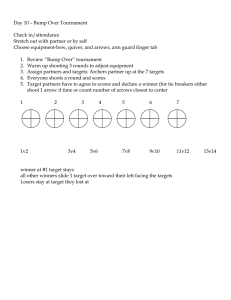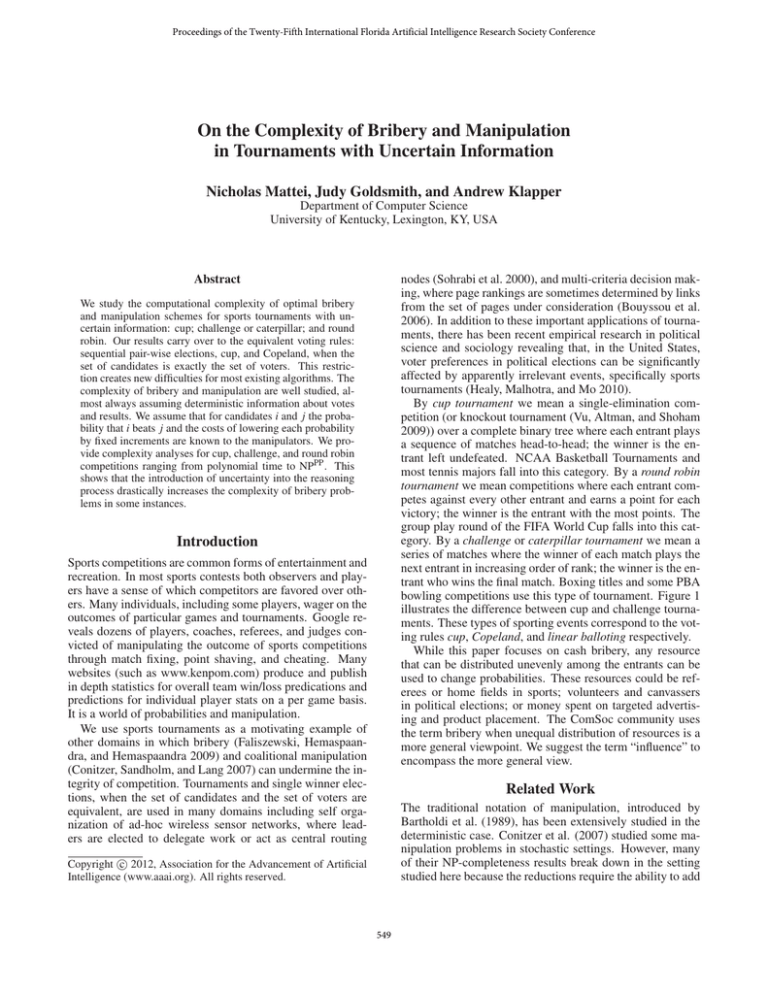
Proceedings of the Twenty-Fifth International Florida Artificial Intelligence Research Society Conference
On the Complexity of Bribery and Manipulation
in Tournaments with Uncertain Information
Nicholas Mattei, Judy Goldsmith, and Andrew Klapper
Department of Computer Science
University of Kentucky, Lexington, KY, USA
Abstract
nodes (Sohrabi et al. 2000), and multi-criteria decision making, where page rankings are sometimes determined by links
from the set of pages under consideration (Bouyssou et al.
2006). In addition to these important applications of tournaments, there has been recent empirical research in political
science and sociology revealing that, in the United States,
voter preferences in political elections can be significantly
affected by apparently irrelevant events, specifically sports
tournaments (Healy, Malhotra, and Mo 2010).
By cup tournament we mean a single-elimination competition (or knockout tournament (Vu, Altman, and Shoham
2009)) over a complete binary tree where each entrant plays
a sequence of matches head-to-head; the winner is the entrant left undefeated. NCAA Basketball Tournaments and
most tennis majors fall into this category. By a round robin
tournament we mean competitions where each entrant competes against every other entrant and earns a point for each
victory; the winner is the entrant with the most points. The
group play round of the FIFA World Cup falls into this category. By a challenge or caterpillar tournament we mean a
series of matches where the winner of each match plays the
next entrant in increasing order of rank; the winner is the entrant who wins the final match. Boxing titles and some PBA
bowling competitions use this type of tournament. Figure 1
illustrates the difference between cup and challenge tournaments. These types of sporting events correspond to the voting rules cup, Copeland, and linear balloting respectively.
While this paper focuses on cash bribery, any resource
that can be distributed unevenly among the entrants can be
used to change probabilities. These resources could be referees or home fields in sports; volunteers and canvassers
in political elections; or money spent on targeted advertising and product placement. The ComSoc community uses
the term bribery when unequal distribution of resources is a
more general viewpoint. We suggest the term “influence” to
encompass the more general view.
We study the computational complexity of optimal bribery
and manipulation schemes for sports tournaments with uncertain information: cup; challenge or caterpillar; and round
robin. Our results carry over to the equivalent voting rules:
sequential pair-wise elections, cup, and Copeland, when the
set of candidates is exactly the set of voters. This restriction creates new difficulties for most existing algorithms. The
complexity of bribery and manipulation are well studied, almost always assuming deterministic information about votes
and results. We assume that for candidates i and j the probability that i beats j and the costs of lowering each probability
by fixed increments are known to the manipulators. We provide complexity analyses for cup, challenge, and round robin
competitions ranging from polynomial time to NPPP . This
shows that the introduction of uncertainty into the reasoning
process drastically increases the complexity of bribery problems in some instances.
Introduction
Sports competitions are common forms of entertainment and
recreation. In most sports contests both observers and players have a sense of which competitors are favored over others. Many individuals, including some players, wager on the
outcomes of particular games and tournaments. Google reveals dozens of players, coaches, referees, and judges convicted of manipulating the outcome of sports competitions
through match fixing, point shaving, and cheating. Many
websites (such as www.kenpom.com) produce and publish
in depth statistics for overall team win/loss predications and
predictions for individual player stats on a per game basis.
It is a world of probabilities and manipulation.
We use sports tournaments as a motivating example of
other domains in which bribery (Faliszewski, Hemaspaandra, and Hemaspaandra 2009) and coalitional manipulation
(Conitzer, Sandholm, and Lang 2007) can undermine the integrity of competition. Tournaments and single winner elections, when the set of candidates and the set of voters are
equivalent, are used in many domains including self organization of ad-hoc wireless sensor networks, where leaders are elected to delegate work or act as central routing
Related Work
The traditional notation of manipulation, introduced by
Bartholdi et al. (1989), has been extensively studied in the
deterministic case. Conitzer et al. (2007) studied some manipulation problems in stochastic settings. However, many
of their NP-completeness results break down in the setting
studied here because the reductions require the ability to add
c 2012, Association for the Advancement of Artificial
Copyright Intelligence (www.aaai.org). All rights reserved.
549
a voting rule here is the requirement that, for a given election with separate sets of candidates and voters, we require
the set of candidates to be exactly the set of voters. Let
Qn×n
be the set of n × n matrices over [0, 1] ∩ Q. Let pi, j
[0,1]
denote the probability that entrant i will defeat entrant j. Let
P = [pi, j ] ∈ Qn×n
. We require that pi, j + p j,i = 1. We choose
[0,1]
k ∈ N+ to discretize the interval [0,1] (we call this the discretization level of the problem). That is, we let each pi, j be
in {0, 1/(k+1), 2/(k+1), . . . , k/(k+1), 1}; i, j ∈ {1, . . . , n}. Notice
that taking k = 0 gives us the deterministic case where each
game is either won or lost with certainty.
The discrete price table, CP , has n2 rows (indexed by
pairs i, j) and k + 2 columns. For each entry in the table
we have the integer value representing the cost to lower pi, j
to a given probability. We assume that all entrants will compete to the best of their abilities and we cannot increase an
entrant’s probability of winning a particular match. Therefore we designate these entries as −−. We also require that
ci, j (pi, j ) = 0. That is, it does costs nothing to have an entrant
compete at its highest level. The entries for ci, j must also be
monotone decreasing; payment of ci, j (l) changes the probability that i beats j to l/(k+1). Bribery must be performed in
one fell swoop, before the first game is played. Outside actors may not have access to the entrants after the start of the
competition (i.e., the tournament is taking place in a remote
or tightly controlled location) so all bribery must be done
beforehand.
We are given a threshold t and an integer-valued budget
B. For cup and challenge tournaments we are given a tree
T with leaves labeled by entrants giving the order of the
matches. Let Pr[ei |P, T ] denote the probability ei wins the
tournament defined by schedule T and probability matrix P.
Example 1 Let k = 3 and n = 4. We might have probability
matrix P:
Figure 1: (1) A challenge tournament and (2) a cup tournament. The winner is the entrant who reaches the top node.
voters that are not in the candidate set. There are also results
relating to manipulation under deterministic information for
cup (Conitzer, Sandholm, and Lang 2007) and Copeland
(Faliszewski et al. 2009). Likewise, the bribery problem
for elections, introduced by Faliszewski et al. (2009), has
been well studied for voting rules under deterministic information. Again, many of these results do not transfer; the
hardness reductions require the ability to introduce an unrestricted number of non-candidate voters.
There has been significant work on the schedule control
problem for cup or knockout tournaments: in the deterministic case by Lang et al. (2007) (for the similar problem of
sequential majority voting), Vu et al. (2009), and Williams
(2010); in the stochastic case by Hazon et al. (2008b). In
addition, there is recent work by Russell and Walsh on
the complexity of coalitional manipulation in sports tournaments (2009). In Russell and Walsh’s model, entrants
may be in a coalition of manipulators that can choose to
lose matches. Given this model, there are natural questions
which arise, such as: “What are the odds my preferred entrant wins?” and “Does my preferred entrant have a chance
of winning?” There is also an extensive body of work on
the elimination problem for sports tournaments. In the elimination problem, the probability that team i beats team j is
known, and the problem is to find the probability that a team
is eliminated given a sports season or playoff schedule (Kern
and Paulusma 2004; Gusfield and Martel 2002).
There has been little work on stochastic models of elections or tournaments; some researchers have begun to address this gap (Erdélyi et al. 2009; Hazon et al. 2008a).
Perhaps the closest notion is that of a possible winner —
a notion intrinsic to reasoning under uncertainty introduced
by Konczak and Lang (2005), with further study by Lang
et al. (2007), and others. These papers address complexity
questions when voters are defined by their (possibly incomplete) preference profiles over sets of outcomes.
e1
−−
0.25
0.50
0.75
e1
e2
e3
e4
e2
0.75
−−
0.75
0.75
e3
0.50
0.25
−−
0.75
e4
0.25
0.25
0.25
−−
and cost matrix CP :
ci, j
c1,2
c1,3
c1,4
c2,1
c2,3
c2,4
c3,1
c3,2
c3,4
c4,1
c4,2
c4,3
Definitions
We define a model for reasoning about sports tournaments
and other head-to-head competitions. The details closely
follow the model proposed by Erdélyi et al. for lobbying in
plurality elections (2009). Consider a tournament with n entrants {e1 , . . . , en }. What distinguishes a tournament from
0.00 0.25 0.50 0.75 1.00
100
40
20
0 −−
30
25
0 −− −−
200
0 −− −− −−
10
0 −− −− −−
10
0 −− −− −−
10
0 −− −− −−
120
75
0 −− −−
200 100
50
0 −−
300
0 −− −− −−
300 200 100
0 −−
300 200 100
0 −−
400 300 200
0 −−
In this paper we focus on the following three types of tournaments. In each case we assume that no game ends in a tie
and every tournament has a unique winner. In the deterministic case a scoring model which includes ties or does not
550
normalize to certain forms for round robin tournaments and
Copeland elections can have significant effects on the complexity of evaluation, manipulation, and bribery (Kern and
Paulusma 2004; Faliszewski et al. 2009).
Evaluation
Pos-Win-$
CCM
C. Bribery
Exact
Challenge Tournament: In a challenge tournament the entrants are ordered e1 , e2 , . . . , en . In the first match, e1 plays
e2 . In the second match, the winner plays e3 , and so on.
The winner of the last match wins the tournament.
Challenge
P
P
P
∈ NP
NP-complete
Cup
P
P
∈ NP
∈ NP
NP-complete
RR
∈ #P
P
∈ NPPP
∈ NPPP
∈ NPPP
Table 1: Complexity results for P ROBABILISTIC T OURNA MENT B RIBERY P ROBLEM . In cases where we have been
unable to provide lower bounds, we note our upper bound
results (∈).
Cup: In a cup tournament we are given a complete binary
tree T with entrants labeled on the leaves. Each internal
node is decided by the competition between the two entrants on the level below. The winner is the entrant who
reaches the top node of the tree.
Results
Round Robin: In a round robin tournament (Copeland)
each entrant plays each other entrant exactly once. In
each match each entrant receives 1 point for a win and
0 points for a loss. The winner of the tournament is the
entrant with the maximum number of points. If more than
one entrant has the same maximum score, we employ a
lexicographic tie-breaking scheme.
Challenge Tournament
We omit the proof of Theorem 2 for space considerations.
We refer the reader to the proofs of Theorems 6 and 7, respectively, as they are similar in style and apply to the more
general case of cups.
Theorem 2 Evaluation and Pos-Win-$ for CT-PTBP are in
P.
With this model we can define our problem instances and
a set of related decision problems for Y ∈ {Challenge Tournament (CT), Cup, Round-Robin (RR)}.
Recall that in the coalitional manipulation problem we are
given a subset M ⊆ E of the manipulating coalition. The
coalitional manipulation problem is a special case of the
bribery problem in our model. In a coalitional manipulation
instance, B = |M| and the cost of bribing members of M is
also 1 (unit priced). The entrants E \ M have bribery prices
equal to ∞ (so they cannot be changed in this scenario).
Name: Y - P ROBABILISTIC T OURNAMENT B RIBERY
P ROBLEM (Y-PTBP)
Given: A probability matrix P ∈ Qn×n
describing the en[0,1]
trants ei in the tournament with some preferred entrant e∗
and (where necessary) cost matrix CP , threshold t, budget
B, set of manipulators M ⊆ E, and ordering T .
Theorem 3 Constructive Coalitional Manipulation for
CT-PTBP is in P.
Evaluation: Is the probability that e∗ wins Y (the sum of
the probabilities of the futures with e∗ a winner) above t ?
Proof. Since there are no budget-related resource bounds
in this problem we can assume our problem is to maximize
e∗ ’s probability of winning by setting the entries for each
m ∈ M in the probability matrix P. We refer to the setting
of M as a strategy. In this instance, CP gives the available
options of probability values for each m ∈ M even though
there are no prices.
There are |M| · (n − |M|) potential contests between coalition and non-coalition members with 2 possible strategies
for each, and there are |M| · |M|−1
contests between coali2
tion members, with 3 possible strategies for each (a loses,
Pos-Win-$: Can we raise e∗ ’s probability of winning Y
above 0 by bribing specific entrants according to CP and
not exceeding the budget B?
Constructive Coalitional Manipulation (CCM): Can we
raise e∗ ’s probability of winning Y above t by strategically setting all the probabilities associated with a subset
M (a coalition) of the entrants?
Constructive Bribery: Can we raise e∗ ’s probability of
winning Y above t by bribing specific entrants according
to CP and not exceeding the budget B?
|M|−1
b loses, both try to win), for a total of 2|M|·(n−|M|) 3|M|· 2
strategies.
Any manipulators who enter the tournament after e∗ need
to deterministically lose to e∗ in order for e∗ to win the
championship. Therefore, for the rest of the proof, we focus on strategies for manipulators who enter the tournament
before e∗ . We construct a strategy in a step by step fashion
starting with the first game that en−1 participates in. We proceed in reverse match order, one game at a time, setting the
strategies for each m ∈ M against each entrant as we go.
Exact: Can we raise e∗ ’s probability of winning Y above t
by bribing specific entrants according to CP and spending
exactly B?
We assume that the reader is familiar with the complexity
classes P and NP and the idea of completeness for complexity classes (Garey and Johnson 1979). In this paper we consider several problems which may be in the functional class
#P (equivalently PP) introduced by Valiant (Valiant 1979).
An intuitive explanation is that #P is the counting analog of
the class NP. For a given decision problem, the functional
class #P asks, “How many solutions exist?”
Step 0: For each m ∈ M, if m reaches e∗ then m chooses to
lose. This sets the strategy against e∗ .
Repeat for: j = 1 to n − 2
551
Step i: For each m ∈ M that enters before en− j , suppose
m reaches en− j . Set m’s strategy against en− j to maximize the probability that e∗ wins by evaluating the 2 or
3 possibilities. This is possible because strategies for
all contests above en− j have been set. Also, if en− j ∈ M,
then for each ei 6∈ M, i < n − j, assuming ei reaches
en− j , pick en− j ’s strategy against ei to maximize e∗ ’s
probability of winning.
in each entry in the table takes polynomial time, so the problem is in P if the budget, B, is polynomial in the size of the
input (e.g., B is input in unary). Otherwise, the algorithm is
pseudo-polynomial.
The table entry D[i, b] is the maximum we can make Fi
via bribes to entrants e1 , . . . , ei , within budget b. Initialize
D[1, b] = 1 for all b.
When we allow bribes to the first i + 1 entrants, the maximum probability (of e∗ winning) attainable either involves
a bribe to ei+1 , and whatever bribes are needed with the remaining money, or does not require a bribe to ei+1 . This
gives us the dynamic programming update.
A bribe to entrant ei+1 (to lose to e∗ ) changes p1,i+1 to
some new value p01,i+1 . We can compute Fi+1 for the given
bribe by Fi+1 = Fi · p01,i+1 .
Let h = max{D[i, b − d] · p01,i+1 } where d is the cost of increasing p1,i+1 to p01,i+1 . We set D[i + 1, b] = max{D[i, b] ·
p1,i+1 , h}. Since there are at most k + 1 bribes for each ei ,
computing {D[i + 1, b] : 0 ≤ b ≤ B} takes O(k · n · B) operations. This is polynomial in k, n, and B. The algorithm runs
in polynomial time with respect to |B| and n.
q
While we have been unable to show NP-hardness for any
version of the constructive bribery problem, Theorem 4,
with the insights listed in this section, leads to the conjecture that the problem is hard.
If we require our outside manipulator to spend exactly
the allocated budget then we can show NP-completeness for
challenge tournaments. Situations which require an organization to spend a budget exactly occur implicitly in many
large organizations and governments. For resources other
than money that could be used, such as referees in sports
tournaments or canvassers in political elections, there is almost always the requirement of exact allocations.
Consider the S UBSET S UM P ROBLEM, which is
NP-complete (Garey and Johnson 1979) : Given:
w1 , . . . , wm , S ∈ N+ , does there exist a subset I ⊆ {1, . . . , m}
such that ∑i∈I wi = S?
Theorem 5 Exact Bribery for CT-PTBP is NP-complete.
Proof. Membership is an immediate consequence of Theorem 2 and a guess and check algorithm.
To show NP-hardness we provide a reduction from S UB SET S UM : For a given S UBSET S UM instance we set up
a challenge tournament with S players such that e∗ always
wins (i.e., e∗ has a 100% chance of winning all games
against all players) and we let t = 0, B = S, and k = 0. We
then create the bribery cost matrix CP with prices equal to
the weights of w1 , . . . , wm . In this situation bribery will have
no effect and we must distribute the money exactly. We have
now established a polynomial time mapping such that there
will be an exact bribery if and only if there is a subset such
that ∑i∈I wi = S.
q
After step j = n − 2, all strategies have been set for all
entrants ∈ M. Whatever the strategy is at lower levels,
Pr(e∗ wins ) is maximized by independently maximizing
each qi j = Pr(e∗ wins |ei reaches en− j ). Since the events “ei
reaches en− j ” for different i are disjoint, the qi j can be maximized independently.
We do 2 or 3 evaluations for each pair of contestants. For
each we require a call to the O(n2 ) evaluation procedure
mentioned in Theorem 2. Therefore we compute an optimal
manipulation strategy in O(n4 ).
q
Theorem 2 gives us membership in NP for the constructive bribery problem since we can verify a bribery plan in
polynomial time. Theorem 3 shows that in a situation of
CCM we can achieve optimal manipulations in polynomial
time. However, our results for CCM do not extend in a
straightforward manner to the situation of priced bribery.
The hope would be that we can apply a bang-for-thebuck greedy algorithm to iteratively choose the cheapest
available single bribe which results in the largest change in
Pr[e∗ |P,T ]/COST OF BRIBE. However, this will not always reach
an optimal solution. This can be illustrated by an example
of CT-PTBP with 4 entrants, e0 , . . . , e3 . Let e0 = e∗ and let
the entrants be situated on T in increasing order from left to
right (e0 in the left most node). We set the cheapest bribe of
entrant e1 to change the probability of winning by 0.25 with
cost 3. We set the bribes for entrants e2 and e3 to change
the probability of winning by 0.15 each with cost 2. If the
budget is set to 4 then the best bang-for-the-buck bribe is
the bribe for entrant e1 . However, the best action would be
to bribe e2 and then e3 . A simple greedy algorithm would
make a non-optimal decision in this case.
In order to eliminate as many complications of the tournament graph as possible we turn our attention to the simplest
case of a challenge tournament. This is a version where e∗ is
potentially involved in every game. This version, which we
call C HALLENGE - THE -C HAMP -PTBP because e∗ is taking
on all challengers, is a common sub-problem for both the
general CT-PTBP and C UP -PTBP problems.
Theorem 4 There is a Constructive Bribery algorithm for
C HALLENGE - THE -C HAMP -PTBP that runs in polynomial
time with respect to B and n.
Proof. With e∗ = e1 let Fi = Π1<i≤n p1,i be the probability
that e∗ wins the first i games. Then the probability that e∗
will be the champion after n rounds is Fn . Without loss of
generality, we assume that B is bounded by the sum of all
possible bribes.
Our goal is to maximize Fn (within budget). We use dynamic programming to build a (n + 1) × B table D. Filling
Cup Tournament
Many of the results for C UP -PTBP use reasoning similar to
that used for CT-PTBP. We assume that each C UP -PTBP
instance is a complete tree. Note that this does not limit our
results; we can always pad an incomplete tree with entrants
who lose to all other entrants and cannot be bribed.
552
Theorem 6 Evaluation for C UP -PTBP is in P.
Proof. This is a proof by construction of a polynomial
time algorithm to compute Pr[e∗ |P, T ] for all entrants. We
construct a table of size n · dlog2 (n)e and use dynamic programming to compute for each i : Lr,i where Lr,i is the probability that entrant i advances to round r (with r = 1 being the
first match ei competes in). When we get to the last round,
our table will contain the probability that each entrant won.
Let G(r, i) be the set of entrants ei may face in round r.
for i = 1 to n do
L1,i = 1
end for
for r = 2 to dlog2 (n)e do
for i = 1 to n do
Lr+1,i = Lr,i · ∑x∈G(r,i) pi,x · Lr,x
end for
end for
Each ei potentially competes against each x in exactly one
round, so there are exactly n(n − 1) ∈ O(n2 ) multiplications
in total, so the total time is O(n4 log(k)2 ).
q
Theorem 7 Pos-Win-$ for C UP -PTBP is in P.
Proof. We provide a polynomial time dynamic programming algorithm to compute the minimum cost such that e∗
has a non-zero probability of winning the tournament.
Let the tournament graph T be a complete binary tree.
Let l be the level of the binary tree starting with 0 at the
bottom level. We then create a vector for each entrant, Vei ,
of size n with all entries initialized to 0 (the cost to get to
the 0th level). Let Vei (l) be the minimum cost for ei to have
a non-zero probability of winning at level l. We construct
the minimum cost matrix, min$, an integer matrix of size n2 ,
as follows: min$i j = 0 if i starts with a non-zero probability
to beat j and the minimum bribe cost min$i j = ci j (1/(k+1))
otherwise.
Figure 2: An example of a minimal cost winner determination such as described in the proof of Theorem 12.
Theorem 9 Exact Bribery for C UP -PTBP is NP-complete.
Round Robin Tournament
Round Robin tournaments are of particular interest in the
social choice community because of their close correspondence to the Copeland election system (Faliszewski et al.
2009). In addition, many papers on sports elimination, including those by Gusfield and Martel (2002) and Kerns and
Paulusma (2004), study sports round robin tournaments for
particular competitions (FIFA, Major League Baseball etc.).
Our model is more general: we do not restrict our model to
deterministic settings or specific tournament formats.
We have been unable to show #P-hardness for the evaluation problem for round robin tournaments, although we
strongly believe this problem to be #P-hard. Hazon et al.
showed that the problem is #P-hard for the voting system
Copeland with an imperfect information model (2008a).
However, their results do not transfer in a straightforward
manner, as their reduction requires the ability to add voters who are not candidates. Likewise Gusfield and Martel
showed a similar problem of determining the probability that
a team is eliminated from a round robin sports competition
is #P-hard (2002). Again, their result relies on the ability of
their model to construct single round tournaments. We omit
the proofs of Theorems 10 and 11 for space considerations.
for l = 1 to log(n) do
for all e ∈ T do
Let G(e, l) be the set of entrants in the sub-tree at
level l containing e.
Ve (l) = Ve (l − 1) + minx∈G(e,l)−G(e,l−1) (min$e,x +
Vx (l − 1))
end for
end for
At the end of execution Vei (log2 (n)) will contain the minimum cost to promote ei to the top level of T with a non-zero
winning probability. We can compare this cost with B and
either accept if Ve∗ (log2 n) ≤ B, otherwise we reject. q
Theorem 6 immediately provides us with the following
corollaries through standard guess and check algorithms.
Corollary 8 Constructive Coalitional Manipulation and
Constructive Bribery are in NP for C UP -PTBP.
We have not been able to show lower bounds results
for CCM or constructive bribery for C UP -PTBP. The result does not hold for cup tournaments because the winner
within separate sub-trees can affect the winning probability
of all entrants in a neighboring sub-tree. We can, however,
straightforwardly transfer our results to the exact case.
Theorem 10 Evaluation for RR-PTBP is in #P.
Theorem 11 CCM, Constructive Bribery,
Bribery for RR-PTBP are in NPPP .
and Exact
Consider the problem M INIMUM C OST F EASIBLE F LOW
(Ahuja, Magnanti, and Orlin 1993): Given: A graph
G(V, E) with vertices V , edges E, source node s, and sink
node t. Each e ∈ E has flow, capacity, and weight. An edge
labeled “[x, y], w” has capacity y and requires flow of at least
x with weight w. Weight is accumulated on a per unit flow
basis (i.e., if x = 2 and w = 3 then the total weight of the edge
is 6). FIND: a flow from s to t such that the flow into each
node is the same as the flow out, all minimum edge flows are
satisfied, and weight is minimal. There is a polynomial time
algorithm and its solution is integral (Ahuja, Magnanti, and
Orlin 1993).
553
Bouyssou, D.; Marchant, T.; Perny, P.; Pirlot, M.; Tsoukás,
A.; and Vincke, P. 2006. Evaluation and decision models.
Springer.
Conitzer, V.; Sandholm, T.; and Lang, J. 2007. When are
elections with few candidates hard to manipulate? Journal
of the ACM 54(3):1–33.
Downey, R., and Fellows, M. 1999. Parameterized Complexity. Springer.
Erdélyi, G.; Fernau, H.; Goldsmith, J.; Mattei, N.; Raible,
D.; and Rothe, J. 2009. The complexity of probabilistic
lobbying. In Proc. ADT 2009, 86–97. Springer.
Faliszewski, P.; Hemaspaandra, E.; Hemaspaandra, L.; and
Rothe, J. 2009. Llull and Copeland voting computationally
resist bribery and constructive control. JAIR 35:275–341.
Faliszewski, P.; Hemaspaandra, L.; and Hemaspaandra, E.
2009. How hard is bribery in elections? JAIR 35:485–532.
Garey, M., and Johnson, D. 1979. Computers and Intractability: A Guide to the Theory of NP-Completeness.
New York: W. H. Freeman and Company.
Gusfield, D., and Martel, C. 2002. The structure and complexity of sports elimination numbers. Algorithmica 32.
Hazon, N.; Aumann, Y.; Kraus, S.; and Wooldridge, M.
2008a. Evaluation of election outcomes under uncertainty.
In Proc. AAMAS 2008.
Hazon, N.; Dunne, P.; Kraus, S.; and Wooldridge, M. 2008b.
How to rig elections and competitions. In Proc. COMSOC
2008.
Healy, A.; Malhotra, N.; and Mo, C. H. 2010. Irrelevant events affect voters’ evaluations of government performance. Poceedings of the National Academy of Sciences of
the United States of America 107(29):12804–12809.
Kern, W., and Paulusma, D. 2004. The computational
complexity of the elimination problem in generalized sports
competitions. Discrete Optimization 1:201–214.
Konczak, K., and Lang, J. 2005. Voting procedures with
incomplete preferences. In Proc. IJCAI 2005.
Lang, J.; Pini, M.; Rossi, F.; Venable, K.; and Walsh, T.
2007. Winner determination in sequential majority voting.
In Proc. IJCAI 2007, 1372–1377.
Russell, T., and Walsh, T. 2009. Manipulating tournaments
in cup and round robin competitions. In Proc. ADT 2009,
26–37. Springer.
Sohrabi, K.; Gao, J.; Ailawadhi, V.; and Pottie, G. J. 2000.
Protocols for self-organization of a wireless sensor network.
IEEE Personal Communications 7:16–27.
Valiant, L. 1979. The complexity of computing the permanent. TCS 8(2):189–201.
Vu, T.; Altman, A.; and Shoham, Y. 2009. On the complexity of schedule control problems for knockout tournaments.
In Proc. AAMAS 2009.
Williams, V. 2010. Fixing a tournament. In Proc. AAAI
2010.
Using minimum cost feasible flows, Russell and Walsh
provided an algorithm to compute minimal constructive manipulations (but not bribery) for deterministic round robin
tournaments when the number of games that e∗ can win is
fixed (Russell and Walsh 2009). Likewise, Faliszewski et al.
showed manipulation results for Copeland under deterministic information elections using feasible flows (Faliszewski
et al. 2009). While our construction is similar to theirs (and
to an earlier construction from Gusfield and Martel (2002)),
there are significant differences between the constructions.
Our results are for a more flexible model, which is able to
encapsulate bribery and manipulation, and works for even
or odd numbers of entrants in the tournament.
Theorem 12 Pos-Win-$ for RR-PTBP is in P.
Proof. We sketch the proof for space considerations. We
construct an instance of a minimum cost feasible flow for our
problem where the solution selects the cheapest bribes that
will allow e∗ to win. In the graph, units of flow correspond to
points (wins) and edge weights correspond to bribery costs.
When we construct the graph correctly, there will be a feasible flow if and only if e∗ can be made a winner. An example
of a constructed graph is shown in Figure 2. If the cost of
this graph is ≤ B then we accept, otherwise we reject. q
Conclusion
We have studied the complexity of bribery in sports tournaments when the results of individual matches are represented
by probabilities. This is a departure from other work in the
field, which only considers bribery in situations where results of games are known and can be manipulated in definite
terms. We have introduced a novel and more general model
that encapsulates both coalitional manipulation and bribery.
The problems, when considered in this probabilistic environment, have an apparent range of complexity from P to
NPPP . The previously studied deterministic cases of evaluation, constructive manipulation, and possible winner, are all
polynomial time decision problems.
We continue to study the open problems mentioned
here regarding bribery and manipulation in stochastic voting/scoring models. Additionally, it would be interesting to
investigate these problems through the lens of parameterized
complexity (Downey and Fellows 1999).
Acknowledgements Nicholas Mattei and Judy Goldsmith
are supported by NSF EAGER grant CCF-1049360. Any
opinions, findings, and conclusions or recommendations expressed in this material are those of the authors and do not
necessarily reflect the views of the National Science Foundation. We would also like to thank Elizabeth Mattei and the
anonymous reviewers for their helpful comments and suggestions.
References
Ahuja, R.; Magnanti, T.; and Orlin, J. 1993. Network Flows:
Theory, Algorithms, and Applications. Prentice Hall.
Bartholdi, J.; Tovey, C.; and Trick, M. A. 1989. The computational difficulty of manipulating an election. Social Choice
and Welfare 6:227–241.
554


